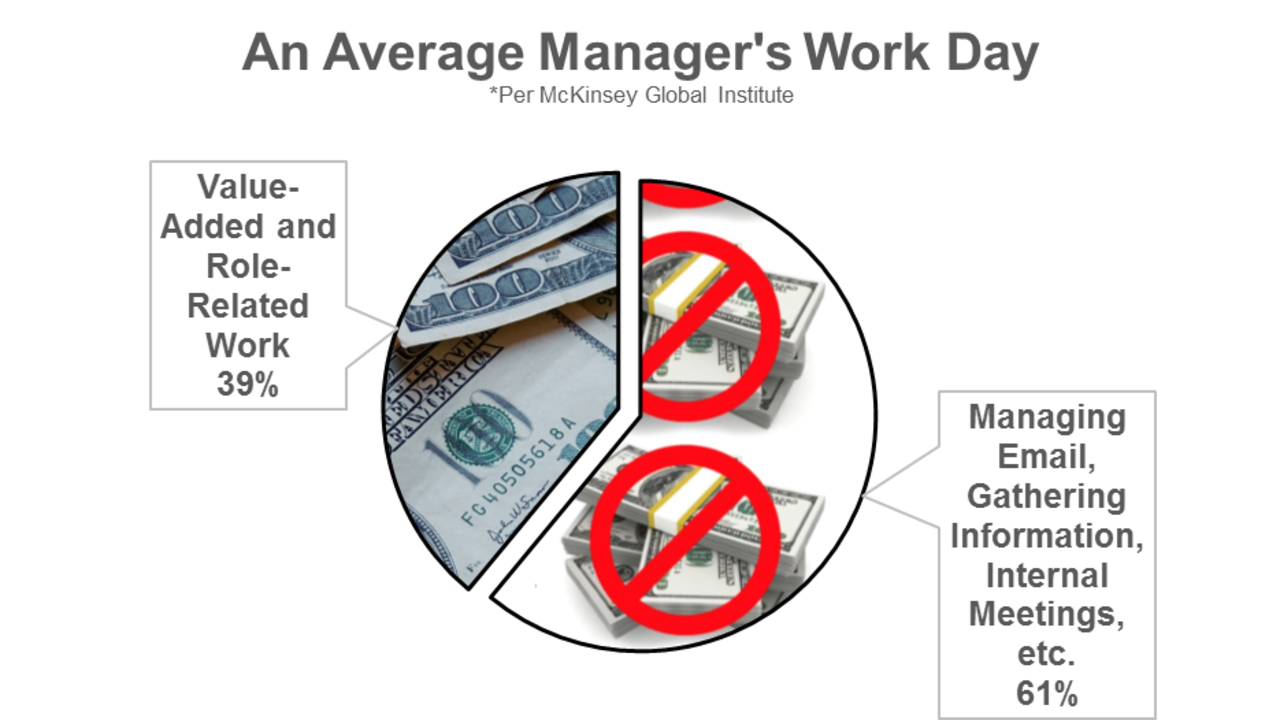Why Most Leaders Don’t Act to Reduce Collaborative Waste

Optimization means leveraging the highest and best use of a limited resource. The highest and best use of your management staff’s time (a limited resource), is NOT managing internal email, searching for information, or attending meetings.
The highest and best use of your management staff’s time is selling, producing, serving, or any other activity that produces revenue for the organization. Other productive uses of their time are innovating, strategizing, and planning.
Yet, when your managers are wading through their email burden, sitting in unproductive meetings (or meetings with useful results that could be achieved in less costly ways) or searching for information, they are not producing value for your organization.
I often cite the McKinsey study which revealed that only 39% of every day is spent producing or doing role-related work due to the time required for internal collaboration. That study is now seven years old and I would wager that the percentage of time available for productive work is even lower today, based upon the feedback I receive from managers. Regardless, every minute spent doing non-value-added work is waste.
I believe there are three reasons why leaders do not act to combat collaborative waste in their organizations:
First, they do not realize there is a problem. They often have administrative assistants that shield them from their own email overload. The assistants weed out nuisance emails, answer simple emails, schedule meetings, and arrange logistics for the leader.
When a leader needs information, others in the organization often retrieve it and then spoon-feed it to the leader to prevent him/her from having to search. In other words, many leaders do not have to deal with as much collaborative waste in their own workdays.
(Even those leaders can benefit from collaborative optimization. With optimization, they could possibly share admins with other leaders to reduce or redirect FTEs in their organizations.)
Secondly, even if leaders recognize there is a problem, they often don’t get worked up about it because the problem does not appear to directly cost them money. Management employees are salaried, so extra hours spent managing burgeoning inboxes or gathering information result in longer or more hectic workdays for the staff, but do not subtract from the organization’s bottom line.
This is faulty reasoning, because staff members cannot produce quality or quantity as readily if they are tired or frustrated from working longer or more intense days. Additionally, due to decision fatigue, context shifting, and longer-term adrenal fatigue, their products or services are often fewer, riddled with errors, and lacking creativity or sufficient thought.
There may not be a direct financial cost of collaborative waste and overload, but the costs find their way indirectly to the bottom line, nonetheless.
The costs could also be passed on to the bottom line via increased turnover and reduced continuity. Employees are less likely to stay in organizations if they feel overloaded or lack the self-satisfaction that results from high personal contribution.
The third and final reason leaders fail to combat collaborative waste is they don’t realize something can be done about it. They assume a heavy email burden is a requirement of a successful workplace. They assume most meetings are necessary. They assume the decades-old method of folders within folders is the only way to file documents. They don’t realize that institutional knowledge and dialog can be cataloged, rather than buried inside employees’ siloed emails.
They couldn’t be more wrong. Thanks to Microsoft technology (Yammer, SharePoint, Teams), organizational collaborative waste can be reduced or eliminated easily enough. It can be done without high investment, since so many organizations already have those platforms via their existing Office 365 licensing.
All it takes for quantum improvement is the knowledge that collaborative waste is a problem, that there are cost-effective ways to reduce/eliminate it, and that a forward-thinking collaborative strategy can ensure optimization and sustainability.
Such is the future of work.
Stay connected!
Join our mailing list to receive cutting edge content.
Don't worry, your information will not be shared.


